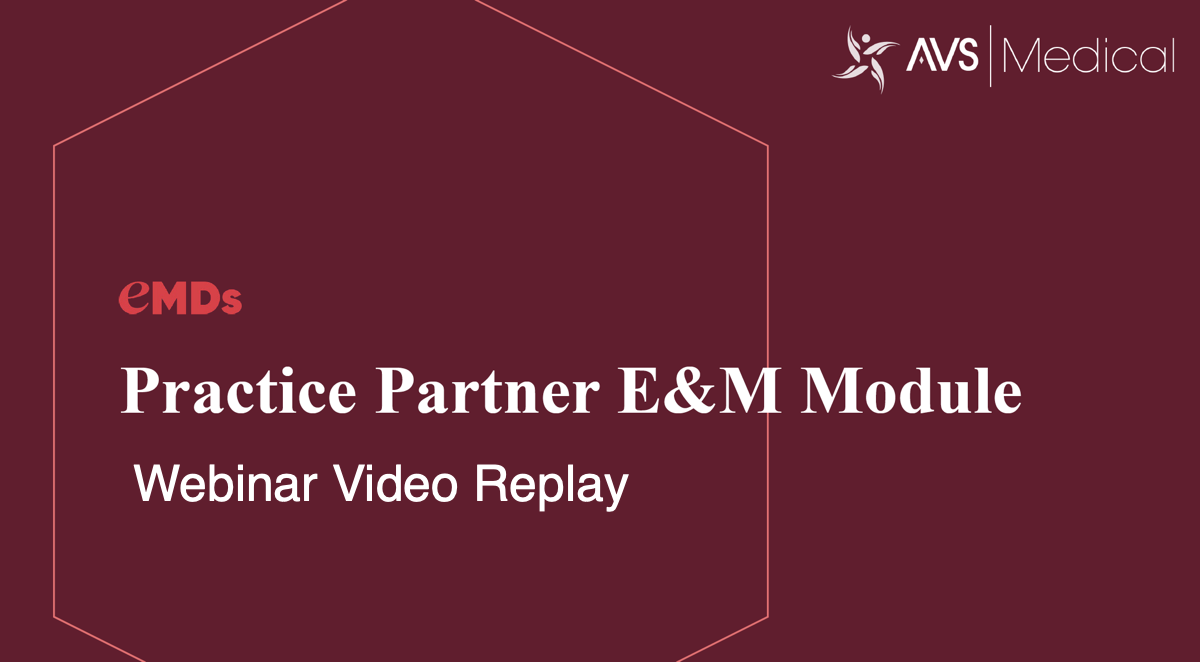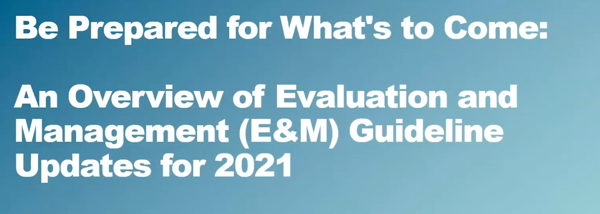Starting January 1st 2021 the new CMS Evaluation and Management or E/M coding scheme goes into effect for outpatient visits. A long overdue and welcome change for providers who are tired of counting bullet points to drive the final code.
Following is a detailed description of the changes along with a video replay of a recent Practice Partner E/M 2021 Changes Webinar and a copy of the slides.
2021 E/M Webinar Replay
Click Here to Download a Copy of the Webinar Slides
This is the first major overhaul of the outpatient E&M services in over 25 years. The stated purpose is to reduce the administrative burden on providers, give them more time to spend with patients and provide compensation for non-face to face patient care that in the past has not been reimbursed.
Starting on the first of the year providers will now choose an E&M code based on either Medical Decision Making (MDM) OR time spent by the provider on the date of the encounter. You’ll have the option to report the E&M code that is most financially advantageous to the practice, and as an added bonus if the proposed rule becomes final the payments will increase over the prior year.
E/M Changes Overview:
- Code 99201 is eliminated
- Providers may use either time or medical decision making to select a code.
- There will be required level of history or exam *
- Time is defined as total time spent, including non-face to face work done that day and no longer requires time to be dominated by counseling
* 2021 Changes to History and Exam
- History and/or Examination must include a medically appropriate history and/or physical examination.
- Providers will have to document to support the level of visit they are reporting.
- The extent of history and physical examination is not an element in selection of office or other outpatient services.
- While the History and Exam need to be documented, they no longer need to be discrete data elements, free text, whether dictated in, typed or chosen from a list or other type of template is acceptable
Medical Decision Making in 2021
MDM in 2021 will be similar to but not identical to the current MDM calculations. The same four levels still apply:
- Straightforward
- Low
- Moderate
- High
However the new MDM table includes easier to understand requirements. Furthermore ambiguous terms like “mid’ have been removed and important terms like “independent historian” have been clearly defined.

Let’s take a deeper dive into the new MDM table and explore some of the definitions.
One element in the level of code selection for an office or other outpatient service is the number and complexity of the problems that are addressed at an encounter. Multiple new or established conditions may be addressed at the same time and may affect medical decision making.
Comorbidities/underlying diseases, in and of themselves, are not considered in selecting a level of E/M services unless they are addressed and their presence increases the amount and/or complexity of data to be reviewed and analyzed or the risk of complications and/or morbidity or mortality of patient management.
The final diagnosis for a condition does not in itself determine the complexity or risk, as extensive evaluation may be required to reach the conclusion that the signs or symptoms do not represent a highly morbid condition. Multiple problems of a lower severity may, in the aggregate, create higher risk due to interaction.
Problem Defined
- A problem is a disease, condition, illness, injury, symptom, sign, finding, complaint, or other matter addressed at the encounter, with or without a diagnosis being established at the time of the encounter
- Problem addressed: A problem is addressed or managed when it is evaluated or treated at the encounter by the physician or other qualified health care professional reporting the service. This includes consideration of further testing or treatment that may not be elected by virtue of risk/benefit analysis or patient/parent/guardian/surrogate choice. Notation in the patient’s medical record that another professional is managing the problem without additional assessment or care coordination documented does not qualify as being ‘addressed’ or managed by the physician or other qualified health care professional reporting the service.Referral without evaluation (by history, exam, or diagnostic study[ies]) or consideration of treatment does not qualify as being addressed or managed by the physician or other qualified health care professional reporting the service.
- Minimal problem: A problem that may not require the presence of the physician or other qualified healthcare professional, but the service is provided under the physician’s or other qualified healthcare professional’s supervision (see 99211).
- Self-limited or minor problem: A problem that runs a definite and prescribed course, is transient in nature, and is not likely to permanently alter health status.
- Stable, chronic illness: A problem with an expected duration of at least a year or until the death of the patient. For the purpose of defining chronicity, conditions are treated as chronic whether or not stage or severity changes (eg, uncontrolled diabetes and controlled diabetes are a single chronic condition).
- Acute, uncomplicated illness or injury: A recent or new short-term problem with low risk of morbidity for which treatment is considered. There is little to no risk of mortality with treatment, and full recovery without functional impairment is expected.
- Chronic illness with exacerbation, progression, or side effects of treatment: A chronic illness that is acutely worsening, poorly controlled or progressing with an intent to control progression and requiring additional supportive care or requiring attention to treatment for side effects, but that does not require consideration of hospital level of care.
- Undiagnosed new problem with uncertain prognosis: A problem in the differential diagnosis that represents a condition likely to result in a high risk of morbidity without treatment. An example may be a lump in the breast.
- Acute illness with systemic symptoms: An illness that causes systemic symptoms and has a high risk of morbidity without treatment. i.e fever, body aches or fatigue in a minor illness that may be treated to alleviate symptoms, shorten the coarse of illness or prevent complications.
- Acute, complicated injury: An injury which requires treatment that includes evaluation of body systems that are not directly part of the injured organ, the injury is extensive, or the treatment options are multiple and/or associated with risk of morbidity. i.e head injury with brief loss of consciousness.
- Chronic illness with severe exacerbation, progression, or side effects of treatment: The severe exacerbation or progression of a chronic illness or severe side effects of treatment that have significant risk of morbidity and may require hospital level of care.
- Acute or chronic illness or injury that poses a threat to life or bodily function: An acute illness with systemic symptoms, or an acute complicated injury, or a chronic illness or injury with exacerbation and/or progression or side effects of treatment, that poses a threat to life or bodily function in the near term without treatment.
Independent Historian
Independent historian(s): An individual (eg, parent, guardian, surrogate, spouse, witness) who provides a history in addition to a history provided by the patient who is unable to provide a complete or reliable history (eg, due to developmental stage, dementia, or psychosis) or because a confirmatory history is judged to be necessary. In the case where there may be conflict or poor communication between multiple historians and more than one historian(s) is needed, the independent historian(s) requirement is met.
Appropriate Source
Appropriate source: For the purpose of the Discussion of Management data element, an appropriate source includes professionals who are not health care professionals, but may be involved in the management of the patient (eg, lawyer, parole officer, case manager, teacher). It does not include discussion with family or informal caregivers.
Risk
Risk: The probability and/or consequences of an event.The assessment of the level of risk is affected by the nature of the event under consideration.
Definitions of risk are based upon the usual behavior and thought processes of a physician or other qualified health care professional in the same specialty. For the purposes of medical decision making, level of risk is based upon consequences of the problem(s) addressed at the encounter when appropriately treated.
Risk also includes medical decision making related to the need to initiate or forego further testing, treatment and/or hospitalization
Social Determinants of Health
Economic and social conditions that influence the health of people and communities. Examples may include food or housing insecurity.
Drug therapy requiring intensive monitoring for toxicity: A drug that requires intensive monitoring is a therapeutic agent that has the potential to cause serious morbidity or death. The monitoring is performed for assessment of these adverse effects and not primarily for assessment of therapeutic efficacy.
Using Time to Decide the Level of E/M Code
As previously mentioned you have the option to use either MDM or Time to determine your code. How you measure time and when you can use time, and what activities are counted as time have changed from 2020 to 2012 in a way that is fairer, simpler and more financially reasonable.
Time - Overview
- Total time spent with patient or family counts
- Does not have to be for counseling or care coordination
- Time includes face to face AND non-face to face time
- Must occur on the day of the encounter
- Only counted for the E/M provider, not staff,Mid levels, etc.
- Time includes time spent before, during and after the encounter (on the day of the encounter)
Time - Detailed View
In the past a provider could only consider time as a deciding factor when the total time was designated as counseling, coordination of care or both took up more than 50% of the encounter.
Now, time refers to the total time spent with the patient or patient's family for both face to face and non-face to face time spent by the E/M provider on the day of the encounter.
Specific examples include:
- Preparing to see the patient (eg, review of tests)
- Obtaining and/or reviewing separately obtained history
- Performing a medically appropriate examination and/or evaluation
- Counseling and educating the patient/family/caregiver
- Ordering medications, tests, or procedures
- Referring and communicating with other health care professionals (when not separately reported)
- Documenting clinical information in the electronic or other health record
- Independently interpreting results (not separately reported) and
communicating results to the patient/family/caregiver
- Care coordination (not separately reported)
Each 2021 office or outpatient E/M code level will specify the time range that applies to the code:
New patient codes:
99202: 15-29 minutes
99203: 30-44 minutes
99204: 45-59 minutes
99205: 60-74 minutes
Established patient codes:
99212: 10-19 minutes
99213: 20-29 minutes
99214: 30-39 minutes
99215: 40-54 minutes
Definitive Guide to Documenting Time in 2021 E/M

Prolonged Services
There are two new codes 99354-99357 that are used when a physician or other qualified healthcare professional provides prolonged service(s) involving direct patient contact that is provided beyond the usual service in either the inpatient, observation or outpatient setting, except with office or other outpatient services will be greatly simplified. Face-to-face and non-face-to-face services on the day of the visit count. This service is reported in addition to the primary procedure.
When submitting a level 5 visit (99215 or 99205) you can add these codes for each additional 15 minutes of time spent.




